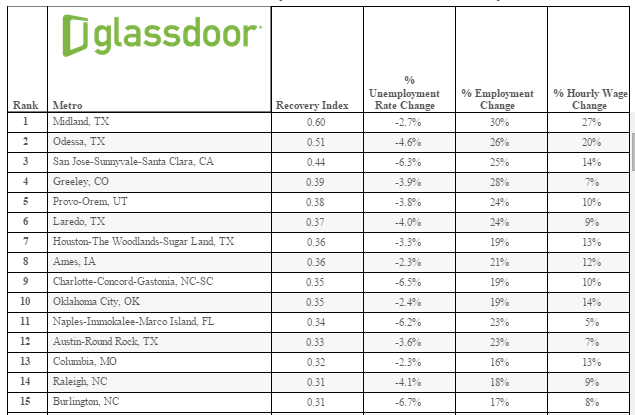This month marks the six-year anniversary since the end of the Great Recession, the most severe economic downturn since the 1930s. Six years later, which American cities have sprung back to life and which cities have lingered?
America’s Recession Rebound Cities
The table below shows which cities have recovered most and least since the end of the last recession in 2009. The ranking[1] is determined by combining three key economic indicators for each city:
- Unemployment: How much the local unemployment rate has fallen;
- Jobs: How much has local employment grown (the number of employed workers in the city); and
- Wages: How much the average hourly wage in the city has grown.
Winners and Losers
The list of rebound cities is dominated by cities in Texas. Of the 15 most recovered cities, five are in the Lone Star State. Midland, TX tops the list with a 2.7 percent drop in its unemployment rate, 30 percent job growth, and 27 percent growth in its average hourly wage. Midland, TX is followed closely by Odessa, TX, with a 4.6 percentage point drop in unemployment, 26 percent job growth, and 20 percent wage growth.
The third most recovered city is the fast-growing Silicon Valley tech hub of San Jose, CA, which has seen its unemployment rate drop 6.3 percentage points, along with 25 percent job growth and 14 percent wage growth. Rounding out the top five most recovered cities are Greely, CO and Provo, UT.
For America’s least recovered cities, Ocean City, NJ leads the way. In fact, this city’s average unemployment rate in 2015 is 4.9 percentage points higher than in 2009. Similarly, the city has seen a 26 percentage point drop in employment, and only 5 percent wage growth since the end of the recession.
Rounding out the five least recovered cities are Decatur, IL, Glens Falls, NY, Pine Bluff, AR, and Carson City, NV. All of these cities have lower total employment today than in 2009, and have witnessed some of the lowest wage growth in the country.



